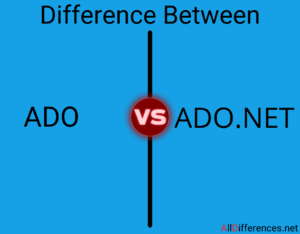Difference between ADO and ADO.NET
Contents
Comparison between ADO and ADO.NET
The Major Difference between ADO and ADO.NET is that ADO is a COM-based Library and ADO.net is a CLR based Library.

Comparison Chart
| ADO | ADO.Net |
|---|---|
| It is a COM(Component Object Modelling) based Library. | It is a CLR(Common Language Runtime) based Library. |
| ADO works in the connected mode to access data. | ADO.Net works in the disconnected mode to access data. |
| Locking features is available | Locking features is not available |
| Data is stored in Binary Format | Data is stores in XML |
| XML integration is not possible | XML integration is possible |
| It uses RecordSet to store the data from datasource | It uses Dataset to store the data from datasource |
| Using classic ADO, you can obtain information from one table or set of tables through join. You cannot fetch records from multiple tables independently | Dataset object of ADO.Net includes collection of DataTable wherein each DataTable will contain records fetched from a particular table. Hence multiple table records are maintained independently |
| In ADO, You can create only Client side cursor. | In ADO.Net, You can create both Client & Server side cursor |
| Derives information about data implicitly at run time, based on metadata that is often expensive to obtain. | Leverages known metadata at design time in order to provide better run-time performance and more consistent run-time behavior. |
| Firewall might prevent execution of Classic ADO | ADO.Net has firewall proof and its execution will never be interrupted |
| You cannot send multiple transaction using a single connection instance | You can send multiple transaction using a single connection instance |
ADO
- It is a COM-based library.
- Classic ADO requires an active connection with the data store.
- The locking feature is available.
- Data is stored in binary format.XML integration is not possible.
- It uses the object named Recordset to reference data from the data store.
- Using Classic ADO, we can obtain information from one table or set of tables through the join. We cannot fetch records from multiple tables independently.
- A firewall might prevent the execution of Classic ADO.
- Classic ADO architecture includes a client-side cursor and a server-side cursor.
- We cannot send multiple transactions using a single connection instance.
ADO.NET
- ADO stands for ActiveX Data Objects
- ADO.NET is a database technology of .NET Framework used to connect the application system and database server.
- ADO.NET is a part of the .NET Framework
- ADO.NET consists of a set of classes used to handle data access
- ADO.NET uses XML to store and transfer data among applications, which is not only an industry-standard but also provides fast access to data for desktop and distributed applications.
- ADO.NET is scalable and interoperable.
More Difference
- Difference Between Properties and Indexer in C#
- Difference Between Static and Dynamic Memory Allocation
